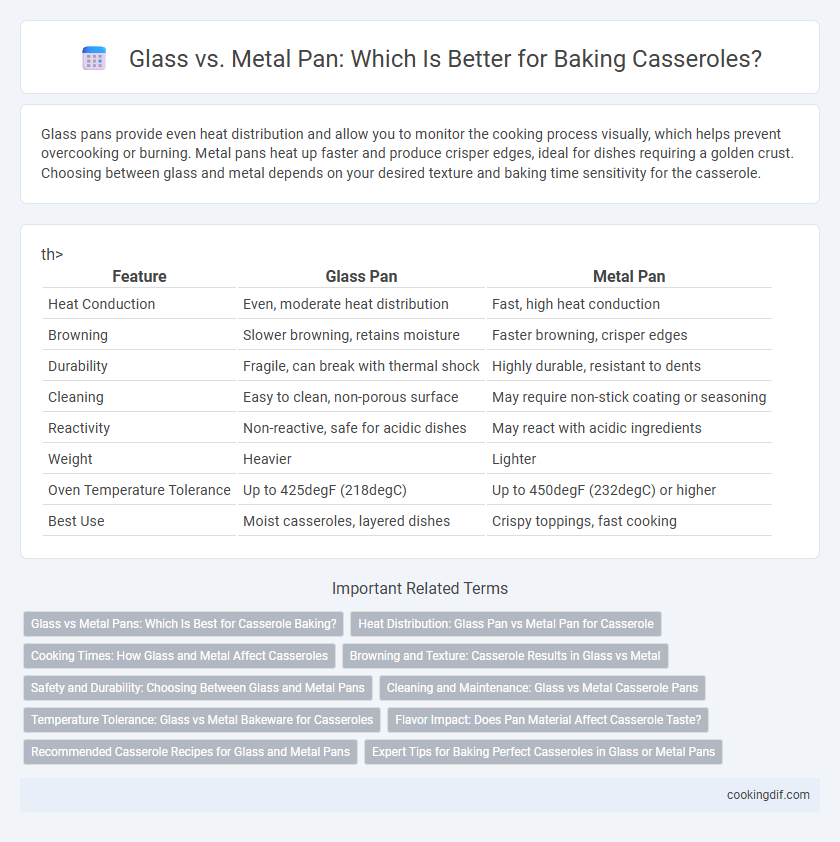Glass pans provide even heat distribution and allow you to monitor the cooking process visually, which helps prevent overcooking or burning. Metal pans heat up faster and produce crisper edges, ideal for dishes requiring a golden crust. Choosing between glass and metal depends on your desired texture and baking time sensitivity for the casserole.
Table of Comparison
| Feature | Glass Pan | th>Metal Pan |
|---|---|---|
| Heat Conduction | Even, moderate heat distribution | Fast, high heat conduction |
| Browning | Slower browning, retains moisture | Faster browning, crisper edges |
| Durability | Fragile, can break with thermal shock | Highly durable, resistant to dents |
| Cleaning | Easy to clean, non-porous surface | May require non-stick coating or seasoning |
| Reactivity | Non-reactive, safe for acidic dishes | May react with acidic ingredients |
| Weight | Heavier | Lighter |
| Oven Temperature Tolerance | Up to 425degF (218degC) | Up to 450degF (232degC) or higher |
| Best Use | Moist casseroles, layered dishes | Crispy toppings, fast cooking |
Glass vs Metal Pans: Which Is Best for Casserole Baking?
Glass pans provide even heat distribution and allow you to monitor the browning process, making them ideal for casseroles requiring consistent cooking and visual cues. Metal pans heat up more quickly and produce crispier edges, preferred for recipes needing a crunchy texture. Choosing between glass and metal depends on whether uniform cooking or a crispy finish is desired for your casserole dish.
Heat Distribution: Glass Pan vs Metal Pan for Casserole
Glass pans excel at retaining heat evenly throughout the baking process, ensuring consistent cooking and browning of casseroles. Metal pans heat up more quickly and provide better conductivity, which results in faster cooking and crispier edges. Choosing between glass and metal depends on the desired texture and baking speed, with glass offering gentle, uniform heat and metal providing rapid, intense heat distribution.
Cooking Times: How Glass and Metal Affect Casseroles
Glass pans retain heat longer and cook casseroles more evenly, often requiring a slightly lower oven temperature and extended cooking time to prevent over-browning. Metal pans heat up quickly and transfer heat more efficiently, resulting in faster cooking and crispier edges but a higher risk of burning if not monitored closely. Adjusting baking duration and temperature based on pan material ensures optimal texture and doneness for casseroles.
Browning and Texture: Casserole Results in Glass vs Metal
Glass pans provide even heat distribution, resulting in consistent and gentle browning that preserves moisture in casseroles, leading to a tender texture. Metal pans conduct heat quickly and offer superior browning and crispier edges, enhancing texture contrast in dishes with cheese or crust toppings. Choosing between glass and metal impacts the casserole's final appearance and mouthfeel, with glass favored for moist, softer bakes and metal preferred for well-browned, textured surfaces.
Safety and Durability: Choosing Between Glass and Metal Pans
Glass casserole pans offer excellent safety for baking due to their non-reactive, heat-resistant properties that prevent leaching and ensure even cooking; however, they are prone to shattering under extreme temperature changes. Metal pans, typically made from aluminum or stainless steel, provide superior durability and heat conduction, but may react with acidic ingredients unless coated with a non-stick layer, potentially affecting food safety. Selecting between glass and metal pans depends on balancing the need for durability with the importance of non-reactivity and consistent heat distribution during casserole baking.
Cleaning and Maintenance: Glass vs Metal Casserole Pans
Glass casserole pans are non-porous and resist staining, making them easier to clean and dishwasher-safe, but they require careful handling to avoid cracking. Metal pans typically heat faster and more evenly but may develop rust or discoloration over time, necessitating thorough drying and occasional seasoning for maintenance. Choosing between glass and metal depends on balancing ease of cleaning with durability considerations for long-term use.
Temperature Tolerance: Glass vs Metal Bakeware for Casseroles
Glass bakeware for casseroles offers excellent heat retention and can withstand temperatures up to approximately 450degF (232degC), making it ideal for even cooking but prone to thermal shock if exposed to sudden temperature changes. Metal pans, typically aluminum or stainless steel, tolerate higher temperatures around 500degF (260degC) and heat up quickly, promoting faster browning and crisping of casserole edges. The choice between glass and metal pans depends on the desired cooking results and required temperature resilience for specific casserole recipes.
Flavor Impact: Does Pan Material Affect Casserole Taste?
Glass pans provide even heat distribution, resulting in well-cooked casseroles with a subtly enhanced caramelized flavor due to the slower, gentler cooking process. Metal pans heat up quickly and create crispier edges, intensifying Maillard reactions that add a richer, slightly toasted taste to the dish. The choice between glass and metal directly influences the texture and flavor profile of casseroles by altering heat conduction and browning levels.
Recommended Casserole Recipes for Glass and Metal Pans
Glass casserole pans excel in evenly distributing heat, making them ideal for casseroles that require slow and consistent baking, such as classic lasagna, vegetable gratins, and fruit crisps. Metal pans, particularly those made of aluminum or stainless steel, heat up quickly and deliver a crispier, browned crust, perfect for dishes like mac and cheese, shepherd's pie, and baked ziti. Choosing the right pan material enhances texture and flavor, with glass suitable for delicate layering and metal providing superior browning and crunch.
Expert Tips for Baking Perfect Casseroles in Glass or Metal Pans
Glass pans heat evenly and retain heat longer, making them ideal for dishes that require slow, consistent baking, while metal pans heat up quickly and provide a better browning effect on the crust. Experts recommend greasing glass pans thoroughly to prevent sticking, as glass surfaces can cause casseroles to adhere more than metal. For metal pans, using foil or parchment can help prevent over-browning, especially when baking delicate casseroles with longer cook times.
Glass vs Metal pan for casserole baking Infographic

 cookingdif.com
cookingdif.com